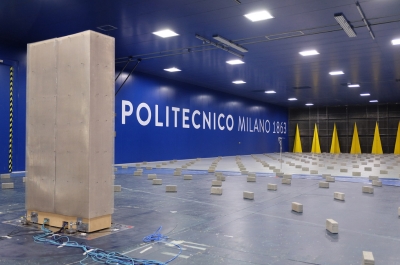
With increasing environmental and energy performance demands, modern architecture has embraced cladding systems that can improve the energetic performance of buildings. Among them, we can find the Permeable Double Skin Façades (PDSFs), a cladding system made by two layers: the inner one is usually realized with glass panels and the outer one is made by brise soleils. PDSFs offer benefits such as enhanced ventilation and solar shading, but their aerodynamic behavior under extreme wind conditions remains largely unexplored, creating uncertainties in their design, since the permeable layer alters wind flow patterns around the building in ways that are not yet fully understood.
That is the main research question of the project SaFEx - Safe Design of Porous Façades Exposed to Extreme Wind Conditions. This initiative, a collaboration between the Department of Mechanical Engineering of Politecnico di Milano and the University of Bologna, aims to improve the understanding and design of PDSFs to ensure their safety and efficiency under extreme wind conditions.
The research project officially started in February 2025, and it tackles these challenges by integrating wind tunnel (WT) testing and computational fluid dynamics (CFD) simulations to develop validated methodologies for designing and testing PDSFs. The research will provide new insights into their aerodynamic performance, with the goal of improving safety while optimizing their structural and energy efficiency. Additionally, the integrated numerical-experimental approach will allow the systematic comparison between CFD and WT results, refining the accuracy of numerical models and improving the reliability of wind load assessments for PDSFs.
Beyond academic advancements, the SaFEx project is expected to have a strong industrial relevance. The findings will benefit architects, engineers, and façade manufacturers, helping them in designing more resilient buildings. The project also aligns with ongoing efforts in Europe to adapt building design to climate change and mitigate risks associated with extreme weather events.
The SaFEx project is set to significantly advance the field of Computational Wind Engineering by developing numerical modeling techniques for porous media applied in civil structures and enhancing Experimental Wind Engineering through wind tunnel testing for porous structures. Furthermore, the research outcomes of SaFEx will contribute to the development of standards and best practices for the safe and efficient design of permeable building envelopes.
By bridging the gap between research and real-world applications, it will help create safer, more efficient, and climate-resilient building envelopes.
